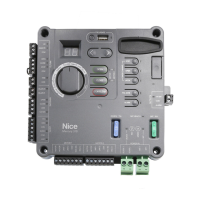Mfg. Part # or
The following sensors have been tested with Nice | HySecurity gate operators by an independent
laboratory and certified to comply with UL 325 7th Edition. Select sensors from this list
for UL compliant gate automation solutions. Contact the sensor manufacturer for specific
recommendations for use.
UL 325 Standard:
• The operator shall monitor for the presence of every device at least once during each open and close cycle (32.1.8)
• It shall not be possible to make simple modifications in the field by adding, suppressing or changing, either on the operator or external
entrapment protection device(s), to bypass, interfere with, or otherwise defeat the monitoring function. (32.1.10)
• Entrapment zones are now defined for each gate type (4.23, 4.24, 4.29, 4.34)
Slide Gates: To enable fully automatic operation, all SLIDE gate operators will require a minimum of TWO monitored external entrapment
protection sensors (one for each direction) to protect entrapment zones in both the open and close direction of travel.
Preferred solution for slide gates: A photo eye for the close direction and a hard-wired edge sensor for the open direction that is mounted to
the face of the leading post of the fence behind the gate. (Reach through injuries are the most common hazard associated with automatic
sliding gates)
Swing Gates: To enable fully automatic operation, all SWING gate operators will require a minimum of ONE monitored external entrapment
protection sensor to protect entrapment zones in either the open or close direction of travel. However, an additional monitored sensor is
required if there is a risk of entrapment in both directions of gate travel.
Preferred solution for swing gates: A photo eye for the close direction and/or a hard-wired wraparound edge sensor
on the leading edge of the gate, which protects for both directions of gate travel.
For more information and latest updates, visit www.hysecurity.com/gatesafety
Recommended External Entrapment
Protection Sensors List
325
1. Leading Edge
2. Bottom Edge Entry / Exit
3. Posts
4. Post Pivot / Pinch Points
5. Arm Movement

